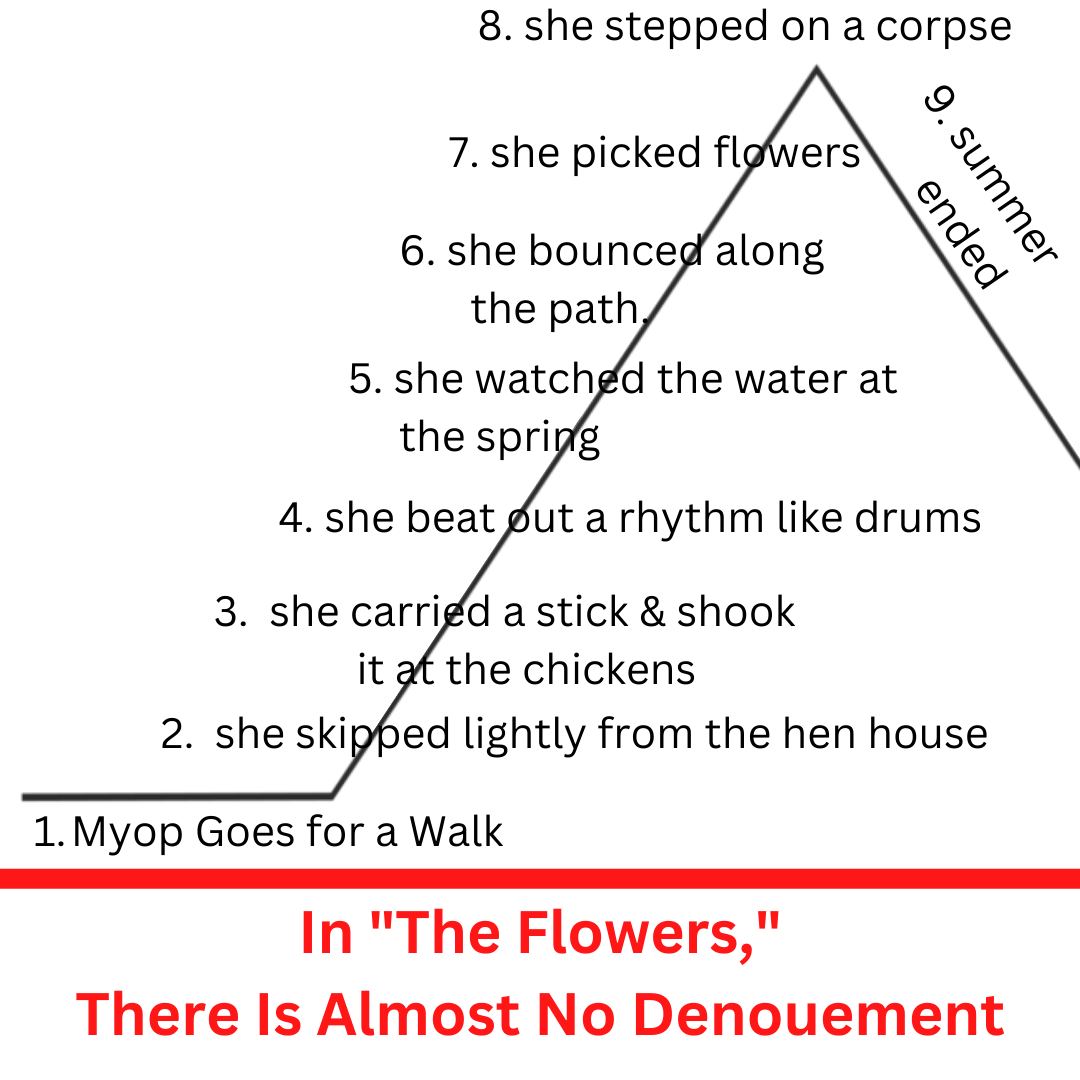XIV – Class XIV
In Literature, What Is Plot?
“Plot is the author’s arrangement of incidents in a story. …
“Events can be presented in a variety of ways. A chronological arrangement begins with what happens first, then second, and so on until the last incident is related. …
“Stories can also begin in the middle of things (the Latin term for this common plot strategy is in media res). …
“Another common strategy is the flashback, a device that informs s about events that happened before the opening scene of a work.” Meyer & Miller, The Compact Bedford Introduction to Literature, pgs. 30-31
PLOT
A Story’s Plot can often be charted on a type of triangle.


- The exposition is the beginning of the story
- But once the story begins, a series of problems occur. One by one, these problems become the rising action.
- Ultimately, something enormous occurs, which causes the plot to be resolved.
- The action begins to fall again.
- Denouement is the resolution of the story. Things have either worked themselves out, or some change occurs.
Structure or Plot in the Pixar Movies – In Literature, Plot is What Pixar Calls Structure.
We will read a story by Alice Walker and we’ll examine it in terms of its plot, or as Pixar calls it, its structure. But first, let’s glance at Alice Walker’s novel which became the movie The Color Purple. Later, we’ll examine Walker’s short story “The Flowers,” but first, let’s look at how Walker handled the plot in The Color Purple.
Miss Celie is the main character or the protagonist of the story. Throughout the book or movie, we learn that Celie’s has suffered a miserable life. She was abused by her father, and after that, she was forced to marry an abusive man. Her only friend was her sister, but Celie’s abusive husband takes that one friend away from Celie.
Plot at this point
1. Celie was abused by her father,
[Because of that]
2. She was forced to marry an abusive man.
[Because of that, she lost her only remaining friend]
As the story progresses, Celie’s situation becomes more and more dire until finally, something snaps, and Celie ends the abuse he has endured.
1. Celie’s father had raped her as a child, and she had given birth to children by him.
[Because of that]
2. After that, she was forced to marry a wicked and abusive man. The only person who had consistently loved Celie was her sister Nettie, and for a while, Nettie was allowed to live in the house where Celie lived after she married. But Nettie did not like Celie’s husband’s behavior.
{Because of that]
3. Celie’s husband evicts Nettie, and for a long time, Celie’s life becomes nothing but consistent misery.
[The misery gets worse — and the action rises]
4. Her abusive husband takes a mistress into Celie’s home. The mistress is a beautiful and well-known entertainer, but Celie is not pretty.
[But things began to soften, as the action continued to rise]
5. The mistress is kind to Celie, and she becomes a type of substitute sister for Celie – and the plot begins to resolve some more, but the top of the climax has not been reached.
6. Sug Avery leaves Celie’s husband and marries someone else. Celie’s husband becomes defeated, and he becomes slovenly and depressed. Celie begins to get stronger.
[The action continues to rise.]
7. Sug and her husband come to visit Celie, and Sug gives Celie a letter from her real sister, who was living in Africa with missionaries. Celie’s husband had not allowed Celie to see the letters from her sister before that time. The missionaries also adopted Celie’s children who had come from her father’s sexual abuse.
This is the top of the mountain. This is the climax that will evoke some resolution.
8. After this visit from Sug, Celie becomes strong enough to leave her abusive husband, and she becomes stronger and stronger.
[This is the falling action.}
The winding back down after the climax is called the story’s denouement, or its resolution. [When Nettie was evicted, she had gone to live with the local preacher and his wife, who had adopted the children born to Celie that had been fathered by Celie’s dad. The preacher, his wife, Celie’s children, and Nettie went to Africa as missionaries. Nettie had written letters to Celie, but Celie’s husband had kept them from her. When Sug Avery gave Celie the letter and reconnected her to her sister Nettie, the climax had been reached. Things would change after that.
in the following scene, Celie’s sister and Nettie return for Celie. Although this is the resolution of the story, it is not the story’s climax. The climax was the grisly scene in which Celie stood up to her husband and ultimately left him. Comfort was coming for Celie, but Celie saved herself.
In the movie The Color Purple, the following scene is the resolution or the denouement:
Return or Fall or Denouement
“Denouement is a French word that literally means the action of untying, from a verb meaning to untie. The English word is pronounced like the French: day-noo-MON. The last syllable has a nasalized vowel instead of the n sound. ” vocabulary.com

Alice Walker’s short story The Flowers is not nearly as powerful as The Color Purple, but in it, you can easily see the plot or the structure of the story.
Let’s examine the much simpler plot in Alice Walker’s story “The Flowers.”
The Flowers
By Alice Walker
Assignment 1: WRITE your answers to the following question:
Considerations for Critical Thinking and Writing from Meyer & Miller, The Compact Bedford Introduction to Literature, pg 39.
- FIRST RESPONSE. How do you interpret the final line of the story? [Consider this in terms of the Seasons as the Circle of Life.]

Summer is the last hoorah before autumn sets in, and autumn is the beginning of the march toward the end.
What is the emotional effect of the brevity of that statement?
In terms of the plot, the climax is abrupt, and the resolution is a quick slide downhill. Unlike the typical triangular plot, which is more or a triangular shape, the plot of “The Flowers” is long on one side–the side of the rising action and short on the other.
